|

Nyiragongo Volcano, Democratic Republic of Congo.
Volcanic eruptions - Part 3
|
Lakes of hot lava are one of the most spectacular forms of volcanic activity, but they are very difficult to see because there's only a few of them in the world at any given time. Such lakes used to exist in craters of Kilawea Volcano (Hawaii), Masaya Volcano (Nicaragua), Erta Alle (Ethiopia), and Stromboli (Italy). But now lava is too deep to be seen in Masaya and Stromboli. The lake in Erta Alle and the giant lake in Kilawea have cooled down. There is still a small lake in PuuOo crater in a more remote part of Kilawea, but it is not particularly spectacular. A small, relatively cold pool of lava exists in Erebus Volcano, but it happens to be located in the Antarctic. So, if you want to see a really impressive lava lake, you have only one option left: Nyiragongo. And don't tell your parents where you are going.
|

Africa has some of our planet's most impressive volcanic features.
Aerial view of Mount Kilimanjaro (5895m/20,210'), Tanzania. |
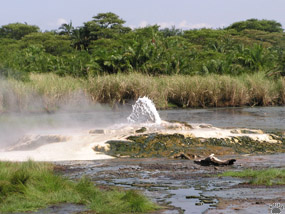
Most of volcanic activity is now concentrated along the Rift Valleys,
from Tanzania to Ethiopia. Hot springs in Semiliki Valley, Uganda. |
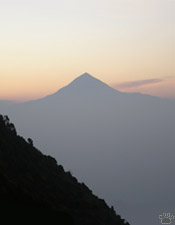
In early morning, you can see the peaks of
other Virunga volcanoes from Nyiragongo.
This is Karisimbi (4507 m) in Rwanda. |
Nyiragongo (3470 m/11,370') is located in Democratic Republic of Congo, a.k.a. Zaire, a.k.a. "Congo-Kinshasa", a.k.a. "Bad Congo". The country is just beginning to recover after 30 years of brutal civil war. But the volcano is very close to Rwandan border, in a safe and easily accessible area. The only trouble you should expect is $100 Virounga Volcanoes National Park entrance fee. From the town of Goma, it's a 17-km drive to the park office and the trailhead. |

Steaming cracks in the slopes mark the
sites of past and future lava breakouts. The
entire area smells of sulfur dioxide. |
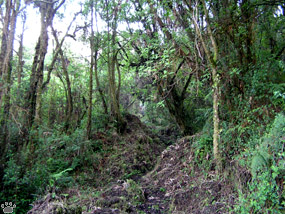
The trail is steep in places, and climbs through beautiful forest of giant
heather, bamboo, and podocarp. |
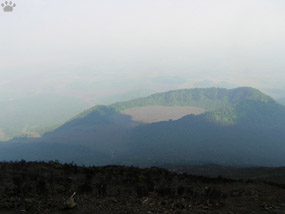
Dozens of small side cones can be seen around the volcano in the
morning. Later in the day, haze or rainclouds usually block the view.
. |
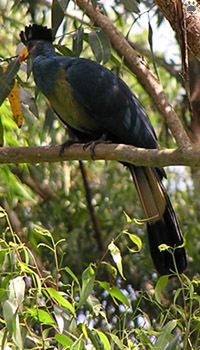
Great blue touraco (Corytaeola cristata),
Nyiragongo Volcano. |
In 1997 and 2002, flows of very liquid lava broke out from cracks in the slopes. They covered 17 km to Goma in just a few minutes, killed dozens of people in refugee camps, and left hundreds of thousands homeless. The eruptions temporarily drained the lava lake in the summit crater; volcanic gases suffocated heather forest on the upper slopes. Now the forest is recovering, and the wildlife is coming back. The climb takes 4-5 hours; there's a lot of rare birds and small mammals along the trail. |
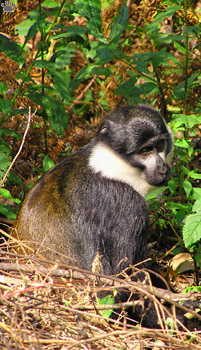
Mountain monkey (Cercopitecus lhoesti),
Nyiragongo Volcano. |
 |
 |
| White-collared ravens (Corvus albicollis) inhabit the areas of bare rock around the summit crater. |

Cliffs of Nyiragongo's summit crater. |
The crater is 1200 m wide and 800 m deep, with a circular terrace halfway down. Descent to the terrace requires using about a mile of ropes. But the view from the rim is spectacular enough. |
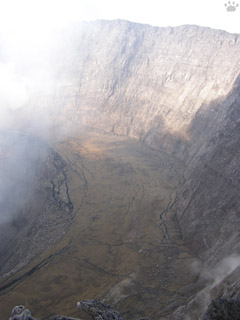
Terrace halfway down the crater. |
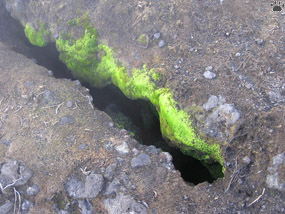 |
 |
| Hot gas exits through numerous vents along the crater rim. The vents are surrounded by tiny gardens of algae (left), mosses and ferns. The gas streams make waiting for nightfall at the summit more pleasant if it's cold and/or rainy. There is even a pit toilet heated up from below (right). |
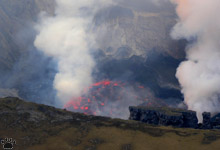
Lava lake, Nyiragongo. |
The lake itself is about 100 m across. It is constantly churning, and the view can be obscured by smoke for up to an hour or two. |
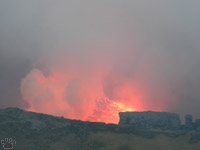
Lava lake, Nyiragongo. |
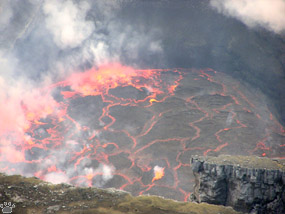 |
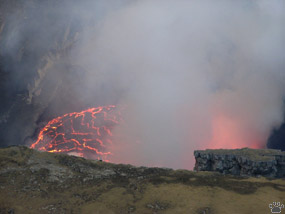 |
| The level of convective activity of the lake changes from day to day. These photos were taken on a "good" day, when fountains of red-hot lava were constantly breaking through the surface, and the entire lake was rapidly rotating like a giant cauldron. |
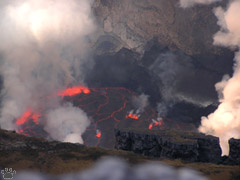
Lava lake, Nyiragongo. |
As the night approaches, you begin to realize that the show is worth $100 entrance fee and all the trouble of getting to the crater. |
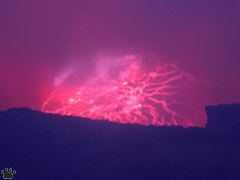
Lava lake, Nyiragongo. |
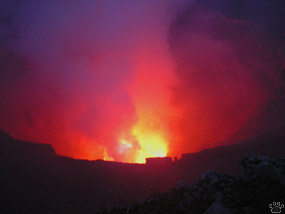 |
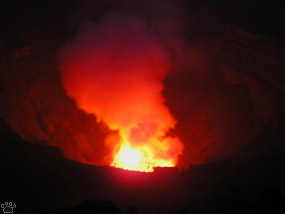 |
| Summit crater at sunset. Nyiragongo emits about 50,000 tons of sulfur dioxide per day - more than any other volcano on Earth. |
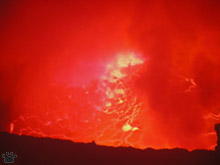
Lava lake at night, Nyiragongo. |
The red glow of violently spinning lava gets so bright that it can be seen from Rwanda. You can spend the rest of the night in a metal hut just below the summit. |
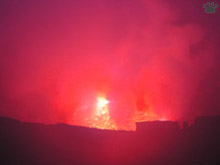
Lava lake at night, Nyiragongo. |

Lava Lake, Nyiragongo Volcano.
Part 4. Oldonyo Lengai
Back to Part 2
Home
|

